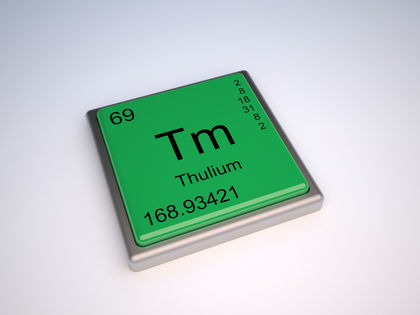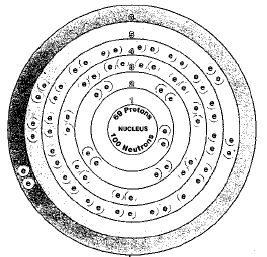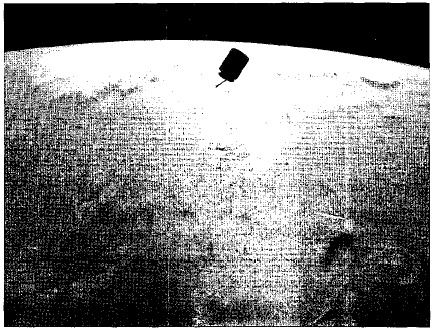THULIUM


Overview
Thulium was given its name in honor of the earliest name for Scandanavia, Thule. The element was discovered and named by Swedish chemist Per Teodor Cleve (1840-1905) in 1879. Cleve made his discovery while studying the mineral erbia. Erbia was one of the many new elements found in a black rock discovered outside the town of Ytterby, Sweden, in 1787. The complete analysis of that rock took more than 100 years. In the process, nine new elements, including thulium, were discovered.
The chemical family to which thulium belongs is sometimes called the rare earth elements. That name is misleading. These elements are not really very rare. But they usually occur together in the earth, and they are very difficult to separate from each other. The more common chemical name for the group of rare earth elements is the lanthanides. The name comes from element 89, lanthanum, often classified as a lanthanide. The family makes up Row 6 of the periodic table. The periodic table is a chart that shows how chemical elements are related to each other.
SYMBOL
Tm
ATOMIC NUMBER
69
ATOMIC MASS
168.9342
FAMILY
Lanthanide
(rare earth metal)
PRONUNCIATION
THU-lee-um
Discovery and naming
In 1787, a Swedish army officer named Carl Axel Arrhenius (1757-1824) found a strange looking black rock outside the town of Ytterby, Sweden. He passed it along to Johan Gadolin (1760-1852), professor of chemistry at the University of Åbo in Finland. Gadolin discovered a new mineral in the rock, now now known as yttria.
Gadolin had no idea how complicated yttria was. Other chemists worked for a hundred years before they completely understood the mineral.
In 1879, Cleve was studying one of the new elements found in yttria. The element had been named erbium by an earlier researcher. Cleve realized that erbium was not really an element, but was made up of three other substances. Cleve called these substances erbium, holmium, and thulium.
The substance Cleve called thulium was not pure thulium, but a compound of thulium combined with other elements. Pure thulium was not produced until 1910 by American chemist Charles James (1880-1928).
Physical properties
Thulium is a silvery metal so soft it can be cut with a knife. It is easy to work with and is both malleable and ductile. Malleable means capable of being hammered into thin sheets. Ductile means capable of being drawn into thin wires. Its melting point is 1,550°C (2,820°F) and its boiling point is 1,727°C (3,141°F). Its density is 9.318 grams per cubic centimeter.
Chemical properties
Thulium is relatively stable in air. That is, it does not react easily with oxygen or other substances in the air. It does react slowly with water and more rapidly with acids.
Occurrence in nature
Thulium compounds occur mixed with other rare earth compounds in minerals such as monazite, euxenite, and gadolinite. Monazite is about 0.007 percent thulium.
Thulium is probably the rarest of the lanthanide elements. Its abundance is estimated at about 0.2 to 1 part per million in the Earth's crust. This still makes it more abundant than silver, platinum, mercury, and gold.

Isotopes
Only one naturally occurring isotope of thulium exists, thulium-169. Isotopes are two or more forms of an element. Isotopes differ from each other according to their mass number. The number written to the right of the element's name is the mass number. The mass number represents the number of protons plus neutrons in the nucleus of an atom of the element. The number of protons determines the element, but the number of neutrons in the atom of any one element can vary. Each variation is an isotope.
At least 16 radioactive isotopes of thulium are known also. A radioactive isotope is one that breaks apart and gives off some form of radiation. Radioactive isotopes are produced when very small particles are fired at atoms. These particles stick in the atoms and make them radioactive.
Thulium is a silvery metal so soft it can be cut with a knife.
Studies have been done on thulium-171, a radioactive isotope of thulium, for possible use in a portable X-ray machine. This isotope gives off gamma radiation. Gamma radiation is very similar to X rays. Gamma rays pass through soft tissues in the body like X rays. But they are blocked by bones and other thick materials. So a small amount of thulium-171 acts just like a tiny X-ray machine. It can be carried around more easily than can a big X-ray machine.
Extraction
Like many lanthanides, pure thulium is made by treating its fluorine
compound with calcium:
Because it is so rare, thulium is also very expensive. It sells for about $50 a gram (about $23,000 a pound).
Uses
Thulium is too expensive to have many commercial uses. One of the few applications is in lasers. A laser is a device that produces bright, focused light of a single color. Thulium lasers work well at high temperatures and need less cooling. Lasers containing thulium are used in satellites that take pictures of the Earth's surface.
Compounds
There are no commercially important compounds of thulium.
Health effects
Although little is known about the health effects of thulium, it is assumed to be toxic. Caution is advised in handling or using it.
Comment about this article, ask questions, or add new information about this topic: